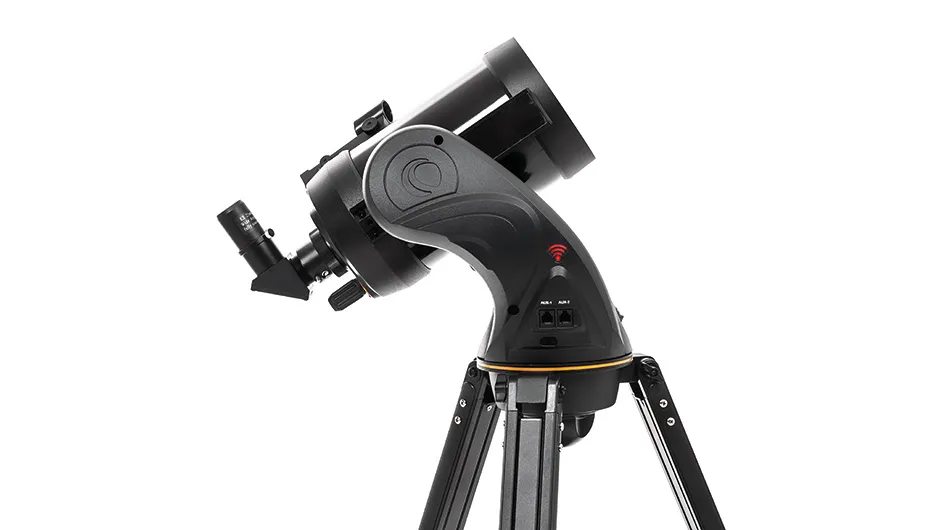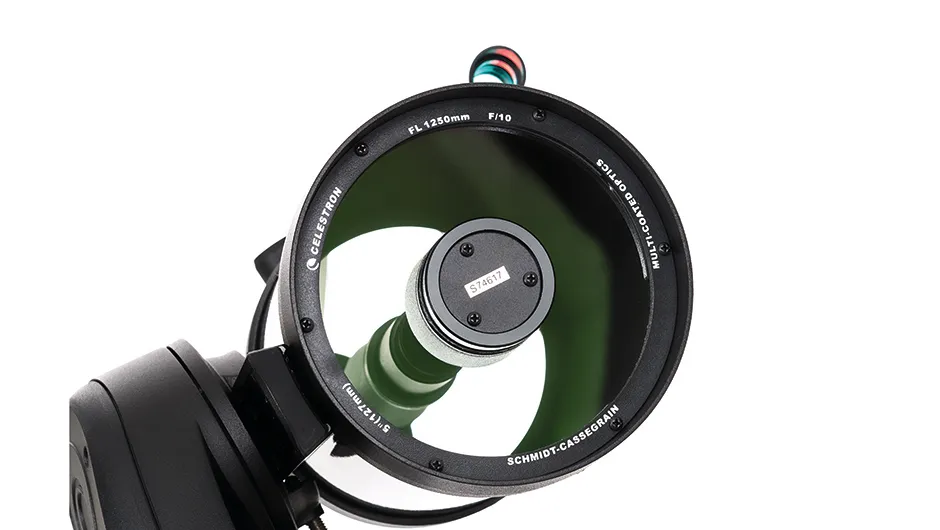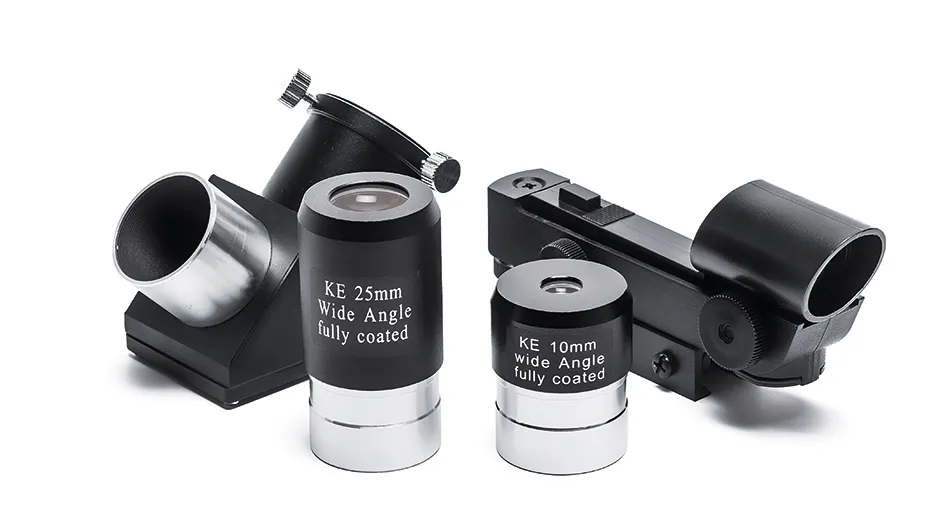So here we look at Celestron’s Astro Fi 5, a Wi-Fi-controlled system for modern times.The system comprises a 5-inch (127mm) Schmidt-Cassegrain telescope on a single fork arm with integrated Wi-Fi, attached to an aluminium tripod.
The telescope has a focal length of 1,250mm giving a focal ratio of f/10, which means this is considered a ‘slow’ system, best suited to observing planets, lunar and bright deep-sky targets.
It looks very smart in its Astro Fi livery while the optical surfaces come with Celestron XLT multi-coatings for a crisper quality view.
This telescope features in our list of the best telescopes for kids and our guide to the best telescopes for observing planets

Easy to set up
The single fork arm has a Vixen-style mounting saddle to which you attach the telescope using a chunky restraining bolt; it was pleasingly easy to install on the tripod.
A padded power pack, which takes eight AA batteries (not included), is provided and you can also use an optional power tank.The power switch has a small red LED to indicate when the system is on, which is handy.
A StarPointer red dot finder, star diagonal and two eyepieces complete the system.
With a focal ratio of f/10 the 25mm eyepiece gives a magnification of x50 while the 10mm eyepiece provides x125, a good range for the kind of targets you’d use this system for.
We powered up the mount, the connected to the inbuilt Wi-Fi with our smartphone via the SkyPortal app and were soon aligned using the on-screen instructions.
With the 25mm eyepiece in place we slewed to Regulus in Leo finding the star pin-sharp across almost all the view with only slight distortion at the edges.We could easily see Regulus and its companion as it is a wide system, so we then aimed for Algieba, a lovely and closer golden pair of stars that just split in the 25mm.
Swapping to the 10mm lens made them a lovely sight indeed.This inspired us to take a look at Castor, another close system that actually has a third companion, viewable when we dropped back down to the 25mm.

Target practice
We caught M42/43, the Orion Nebula, just before it set over the horizon, enjoying its wealth of nebulosity while having a good view of the Trapezium stars at the centre.
The supernova remnant M1, the Crab Nebula, was a lovely oval glow at both magnifications while the Eskimo Nebula, NGC 2392 – which is a planetary nebula – was small but a faintly greenish blob even in the 10mm eyepiece.
Turning our attention to the deep sky we found we could just fit the wonderful galaxy pair M81/M82 in the view of the 25mm.
M81 was a pale oval, while using the 10mm we could see a subtle mottling along the sliver that is M82 – nice! We tried for NGC 2903, which is a bright galaxy in Leo, but surprisingly we couldn’t find it in the SkyPortal app.
We could have connected via our Sky Safari v6 app, which provides even more targets, but to be fair to the SkyPortal app, it does cover the main Messier and Caldwell objects along with a searchable list of popular named targets including the main Solar System objects.
Once the Moon was available we enjoyed a wealth of detail with the 25mm lens giving a full-disc view and the 10mm giving great close-up views of craters such as Tycho and Clavius.
The only easily viewable planet for us that night was Jupiter later in the evening, and we were rewarded with views of the gas giant’s two main belts, polar hoods and all four of its Galilean moons.
The Astro Fi 5 is a decent system aimed at beginners who want to enjoy the night sky using their smart devices.
It certainly managed to fulfil its criteria and can be recommended.

Outstanding feature: Wi-Fi and the SkyPortal app
The Wi-Fi/smartphone control of the Astro Fi 5 system worked well every time we connected.The SkyPortal app is available for iOS or Android from the respective stores.
Installation is very fast. Power up the mount and it automatically sets up a Wi-Fi spot which you can connect to. We used both our iPhone 6S+ and iPad Pro to connect with no fuss.
Open up SkyPortal and chose ‘connect and align’ and follow the onscreen instructions to align on three stars.Once successful you can use the app to explore any of the targets or manually slew the telescope using the onscreen arrows.
You can even use your smartphone’s compass to aim at any target to get the telescope to slew across to view it.Overall the pointing accuracy was good with all targets appearing in the 25mm eyepiece’s field of view.
Optic
The Astro Fi 5 is a Schmidt-Cassegrain telescope comprising a primary mirror and a corrector plate with the secondary mirror attached to the corrector.It has a ‘long’ focal length of 1,250mm giving a focal ratio of f/10, although strictly speaking it works out at f/9.8. All optical surfaces are multicoated.
Tripod
The tripod has aluminium telescopic legs that can be extended and was sturdy to use.The mount affixes very easily with a single underside bolt from the tripod which holds it firmly in place.The spreader tray can hold two 1.25-inch eyepieces and there is a rubberised smartphone holder.
Single arm mount
The single arm mount holds the electronics and gears and is very solid in build quality.The mount has a Vixen-style saddle for attaching the telescope, with a good, chunky retaining bolt giving a solid grip to the Vixen bar on the telescope.
Accessories
The StarPointer red dot finder worked well for aiming the telescope, especially during alignment.Two eyepieces are provided, 25mm and 10mm, which give magnifications of x50 and x125 along with a 90° star diagonal.The eyepieces gave good views of all our targets but especially of the planets and the Moon.
Ports
The mount incorporates several ports including two aux ports, one of which can be used for an optional hand controller; the other is a spare port for future use.There is also an integrated Wi-Fi adaptor, a 12V DC power connector and on/off switch with an illuminated ‘on’ light.
Vital stats
- Price £599.00
- Aperture 5-inch (127mm)
- Weight 7kg
- Supplier David Hinds Ltd
- Telephone 01525 852696
- www.celestron.uk.com
This review originally appeared in the June 2018 issue of BBC Sky at Night Magazine